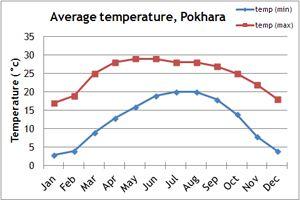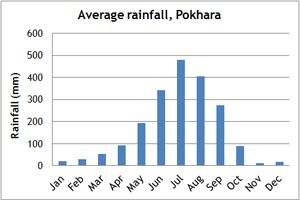Our grading system explained
What makes Annapurnas so special?
If you are thinking of going trekking in Nepal, especially for the first time, then you are most likely to head to the Everest region or the Annapurnas. But for sheer variety of trails, classic high mountain scenery and cultural interest, it’s hard to beat trekking in the Annapurnas for that quintessential Himalayan trekking experience.
One of the great attractions of the region is that treks in the Annapurnas appeal to all levels of experience and ability. You don’t need to go particularly high or be a ‘hard core’ trekker to enjoy the stunning mountain scenery that the Annapurnas has in abundance. You can start with a relatively easy-paced trek in the beautiful lower reaches of the Annapurna foothills, trekking between high quality lodges set against a backdrop of stunning mountain views. Venture a little further and higher and you can trek into the heart of the Annapurna Sanctuary. This classic tea house trek in the Annapurnas is relatively low altitude by Himalayan standards and takes you to a vast amphitheatre of some of the world’s highest mountains as well as to the Annapurna Base Camp where you may meet climbers preparing to scale the giant peak.
If you are seeking more remote trekking in the Annapurnas you can get off-the-beaten-track by taking the trail across the Namun La - a spectacular trek in the Annapurna mountains that few others will have completed.
Whichever of our holidays in the Annapurnas you choose you can always be assured of a warm welcome from the wonderful people of the region, particularly the Gurkhas who call the Annapurna mountains home.
Whether you are considering your first trek in Nepal or you are returning to the Himalaya, take a look at our range of Annapurna treks as there will undoubtedly be one that’s just perfect for you.
Annapurna Region, Nepal Trekking
The quintessential Himalayan landscape - brilliant green terraces rising above plunging gorges, ancient paths through classic Nepali villages and some of the most beautiful snow-capped mountains in the world.
Show me:
11 Holidays
- Trek in a truly remote region of Nepal far from the busier trails of the nearby Annapurnas.
- Discover magnificent, varied and unspoilt scenery from lush river valleys to dramatic high-desert terrain.
- Cross the Kang La Pass and enjoy sweeping vistas of the Annapurna Massif.
- Explore the Tibetan-style villages of Naar and Phu where life has remained little-changed for centuries.
- Stay in simple tea houses for an authentic Nepali trekking experience.
Flight inclusive from £3450, Land only from £2250
- A scenically spectacular little-known alternative to the Annapurna Sanctuary trek
- Wild terrain with towering cliffs, waterfalls, glaciers, a brilliant blue lake and a host of Himalayan giants
- Trek high point at French Advance Base Camp, 4,305m, with staggering 360-degree mountain views
- Four-star hotel in Kathmandu, exciting mountain road to the start of the trek, and a well-paced ascent
- Remote camping trek - the equal of anything in the Himalaya but in just two weeks London to London
- Enjoy the Laxmi Pooja festivities (on selected October departures)
Flight inclusive from £3345, Land only from £2250
- An accessible yet genuine wilderness trek – few trekkers, or even locals, use this trail.
- A wild trek with breath-taking scenery that fits into a two week holiday.
- Cross the remote and challenging Namun Pass, 4,850m/15,912ft.
- Enjoy incredible views of the Langjung Himal, Annapurnas, Machhapuchhare and Manaslu.
Flight inclusive from £3375, Land only from £2195
- Complete the classic trek into the Annapurna Sanctuary, trekking with a Sherpa guide
- Trek to Machhapuchare Base Camp & Annapurna Base Camp, 4,130m/13,550ft
- Enjoy sunrise views from Poon Hill
- Follow the trail through picturesque villages and experience Sherpa culture
- Stay in traditional tea houses on trek and a four-star hotel in Kathmandu
Flight inclusive from £3090, Land only from £1840
- Tour the ancient cities of Bhaktapur, Kathmandu, Patan and visit Lumbini - the birthplace of Buddha
- Enjoy village walks with stunning Himalayan views of the Annapurnas and Everest
- Go wild at Chitwan National Park with two full days of wildlife watching activities
- Stay in top quality hotels and lodges including Dwarika's fabulous Heritage Hotel
Flight inclusive from £4190, Land only from £3195
- Experience a genuine wilderness trek in the heart of the Annapurna mountains
- Cross three challenging passes: the Kang La, 5,300m, the Mesokanto La, 5,120m and the Namun La, 4,850m
- Enjoy incredible close-up views of the Annapurnas, Machhapuchare, Manaslu and Dhaulagiri
- Camp at 5,000m at stunning Tilicho lake - a unique experience
- Explore the delightful mountain villages of Naar and Phu
Flight inclusive from £5735, Land only from £4385
- Varied trekking through beautiful Himalayan scenery and delightful villages
- Enjoy a sightseeing tour of the cultural highlights of Kathmandu and a boat ride in Pokhara
- Stay at the best trekking lodges in the Annapurnas and a top quality hotel in Pokhara
- Relax in a fabulous 5 star hotel in Kathmandu after the trek
- Extend your holiday with a range of options
Flight inclusive from £3285, Land only from £2295
- Enjoying spectacular views of the Kathmandu valley and Himalayan peaks from Haatiban and Champa Devi
- Relaxing at Summit River Lodge with the sound of the Trisuli River below
- Spending your last night at Dwarika's - one of the finest hotels in all Kathmandu
- Getting under the skin of the real Nepal with off-the-beaten-path walks through timeless villages
- Staying at beautifully located lodges and hotels with bags of style and character
- Sightseeing in Pokhara with the Annapurna range as a breathtaking backdrop
- Wildlife watching in Chitwan National Park
Flight inclusive from £4100, Land only from £2825
- Trek to Machhapuchare Base Camp and Annapurna Base Camp
- Stay in up-market lodges, and the best tea houses higher up the trail with many extra services included
- A perfect Himalayan trek through classic high mountain scenery to explore the heart of the Annapurna
- Enjoy a high quality hotel in Kathmandu and tour the city's main sights
Flight inclusive from £4325, Land only from £3075
- Explore the artistic and cultural heritage of ancient Kathmandu
- Enjoy stunning views of the Himalayan mountains
- Visit all the key cultural sights in Bhutan, including iconic Taktsang Monastery
- Experience traditional Nepalese village life in Bandipur
- Enjoy time in scenic Pokhara with a boat ride on the lake
- Stay in comfortable hotels throughout
Flight inclusive from £4520, Land only from £3495
- Stay in high quality trekking lodges with lots of home comforts
- Relax at a high quality hotel in Kathmandu and tour the city’s main sights
- Discover the Annapurna foothills and the Everest region on two well-paced treks with stunning views
- Enjoy the best trekking experience with excellent acclimatisation and first rate leaders
Flight inclusive from £4915, Land only from £3775
- 1
Introduction
The variety of routes, the easy accessibility and a landscape which defines the Himalaya, has made the Annapurnas the most popular trekking destination in Nepal. Whether it’s a classic high mountain trek or gentle day walks in the foothills – the Annapurnas provide the most breathtakingly beautiful backdrop.
In addition to the scenic splendour, the Annapurnas are home to a diverse range of ethnic groups with a rich variety of language and traditions including the famous Gurkhas who have longed served with the British Army.
Another world renowned trek in the region is the Annapurna Sanctuary Trek – with less duration and at lower altitude than the traditional Annapurna Circuit (which has now been spoiled by road incursion), but with equally dramatic scenery and tea house accommodation, it an ideal first Himalayan trek. Alternatively, the lesser known base camp at Annapurna North can also be reached in just six days, via the scencially stunning route used by the 1950 French expedition team.
If you want to really get off-the-beaten-track and enjoy a remote trek without the crowds then our Namun La Wilderness Trek or Naar Phu Circuit Trek are just the trekking adveture for you. You can also combine both of thse in our Grand Annapurna Traverse.
If tea houses or camping are not for you, than you can still trek in the Annapurnas on either our Gentle Trekking & Luxury Lodges holiday or Annapurna Base Camp in Style. Both of these holidays use top quality trekking lodges with many homely comforts.
Related news and articles
Top 10 reasons to go trekking in the Annapurnas
Trekking guide to the Annapurna region
My trek to Annapurna North Base Camp
Key Facts
- Main town of the region: Pokhara
- Currency: Nepalese Rupee
- Power supply: 220-240 v, 50 hz
- Sockets: varies - 2 or 3 round pin sockets
- Language: Nepali, Gurung dialect common in Annapurnas
- Time difference: GMT +5.75 hours
- Visas/permits: An entry permit (ACAP) is required to enter the Annapurna region - Mountain Kingdoms obtains this on behalf of their clients.
- Religion: Hindu and Buddhist
- Popular dishes: daal bhat and apple pie
- Popular drinks: tea (chiya), home brewed beer (chang)
- Did you know: Many of the Gurkhas serving in the British Army come from the villages in the south of the Annapurna region.
- FCDO link: FCDO travel advice for Nepal
Climate
When is the best time to travel to the Annapurna region of Nepal?


It is possible to travel to Nepal throughout much of the year, though for walking and trekking in the Annapurna region of Nepal, the best time to go is in spring (March-April) and autumn (October-November). Our temperature and rainfall charts will give you a guide to the climate in the Annapurnas.
Autumn is thought to be the best time to visit the Annapurnas. With dry weather and crisp, clear skies, the mountain views are at their best. The countryside is green and lush, following the summer monsoon. However, during this period the popular trails can be busy, and flights book up quickly, so do book in advance if you want to trek in Nepal during the autumn. We've introduced many treks which will get you off-the-beaten-path, and away from the crowds during this season.
In winter, the days are generally dry and bright, though at altitude the evenings will be extremely cold, and some high passes can be blocked by snow. Although a high-altitude trek may not be possible, winter can be a great time to visit Nepal, as there are fewer tourists. There are some fantastic walking and trekking holidays which are perfect for an adventurous winter holiday. Our Gentle Trekking & Luxury Lodges holiday in the Annapurna Foothills is particularly suitable.
Between March and April, the weather warms up, and a whole range of trekking options in the Annapurna's are available. Skies may be more cloudy than in autumn, but the beautiful rhododendron and magnolia will be in bloom. Some of our holidays are timed to depart during the Easter period.
In summer, from June to August, Nepal experiences the monsoon rains. As well as travel disruption, there are no mountain views, so trekking in the Annapurnas or the Everest region during the summer is not worthwhile. There are alternative mountain ranges which are at their best during the summer due to lying in the rain shadow, such as Mustang and Dolpo.
If you can't make the dates of our group departures, then take a private departure on dates to suit you, or we can create a Tailor Made holiday to the Annapurna region of Nepal, especially for you and your family or friends.















